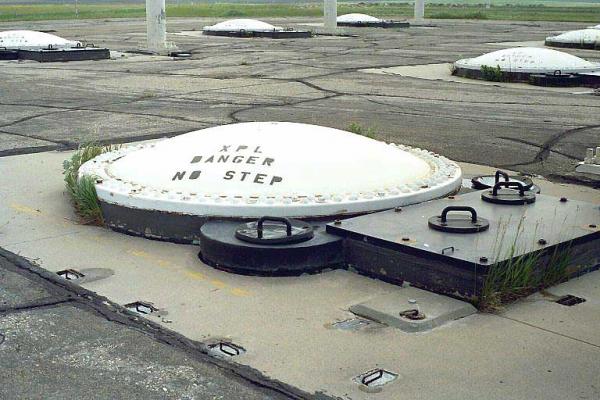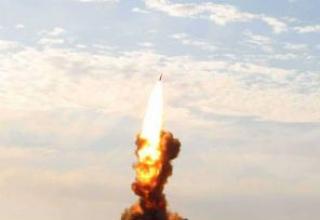The Sprint anti-missile was developed in 1964 by the American company Martin Orlando and is designed to intercept the warheads of intercontinental ballistic missiles and medium-range missiles at relatively low altitudes after their re-entry into the atmosphere.
"Sprint was one of the elements of the US Safeguart missile defense system. This system was formed by two lines of missiles, each carrying small nuclear charges. The first line - LIM-49A "Spartan" missiles are designed to intercept separating warheads of the enemy at distances up to 500-700 km, while the "Sprint" missiles are designed to intercept the remaining warheads, which are about several kilometers away. Targets are captured by an observation radar and the missiles are accompanied by several small radar stations.
Composition:
The anti-missile is a two-stage (see layout diagram), configured as a large cone. "The Sprint has very high accelerations - at least 30-40g at launch and up to 100g at target intercept. Control - radio command.
As one of the variants of combat equipment to combat the warheads of attacking missiles on "Sprint" missiles were installed neutron warheads. According to calculations of American specialists, fast neutrons formed by detonation of such a warhead and possessing high penetration capability will pass through the lining of enemy warheads and cause damage to their electronic equipment. In addition, neutrons interacting with the nuclei of a warhead's uranium or plutonium atomic detonator may cause their fission. Such a reaction will occur with high energy release, which could eventually lead to the heating and destruction of the detonator, and hence to the failure of the entire warhead charge.
When intercepting a target with a Sprint anti-missile, the control system uses the principle of "filtering" objects in the atmosphere, which allows the warhead to be distinguished from light decoys.
The missile is launched from underground launch silos, from where it is ejected as a result of the ignition of a fuel charge located at the base of the silo. The first stage power unit (Hercules solid propellant engine - thrust up to 300000 kg) is activated after the missile leaves the launch shaft and accelerates the missile to the speed of about 10 M in less than 5 seconds.
In creating the rocket, a number of complex tasks were solved. The main of them is the creation of reliable ablative heat protection, which provides protection against aerodynamic heating, which reached a temperature of about 3400°C due to the high speed of movement. Since the missile could be used in a complex combat environment, including group missile applications, the Sprint was designed with a high margin of safety to withstand close nuclear explosions.
At high speeds, the rocket is surrounded by plasma heated to high temperatures, which makes it very difficult for the radio waves to pass and thus transfer control commands on board. To solve this problem, the tracking radar beam had a power of about 1MW and a width of about 1 degree.
The North Dakota missile system is the only missile defence system ever deployed by the United States before 2001. The pyramid-shaped building is an escort radar designed to control and target the Spartan and Sprint missiles. The long-range detection radar is located outside the Beton launch site in North Dakota. The launch pad contains fortified underground silo launchers for 30 Spartan and 16 Sprint missiles, an underground diesel power plant, and a command communication center.
The actual intercept range of "Safeguard" system did not exceed 200-300 km from the object of defense. In 1976, the United States, having ascertained that its BMD was ineffective, mothballed it six months after it began operation, and it has not been operational since.
Characteristics:
| The length of the rocket, m | 8.2 |
| Maximum case diameter, m | 1.4 |
| Start weight,kg | 3409 |
| Flight Speed, M | up to 12 |
| Target intercept altitude, km | 30 |
| Range,km | 46 |
| Hull cone semiangle, deg | 4.25 |
Testing:
The first stage of testing the Sprint missile was held from November 1965 to August 1970 at the White Sands test site.
The second stage of operational tests - at Kwajalein Atoll since December 1970.
On December 23, 1970, the Sprint missile intercepted a real target for the first time.
17 March 1971 - first double launch, at intervals of less than 1 second. Tests successfully intercepted the target - LGM-30 Minuteman missile warhead launched from Vandenberg Air Base.
May 7, 1971 - successfully intercepted the warhead of the sea-based missile "Polaris".
Tests at Kwajalein Atoll continued until December 1973.
Sources:
- В.В.Телегин"Развитие и совершенствование ракетного стратегического,оперативно-тактического,зенитного оружия и СУ за рубежом",1970г.;
- http://www4.tpgi.com.au/users/mpainf/missiles/sprint.html





